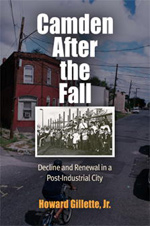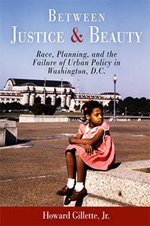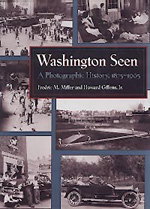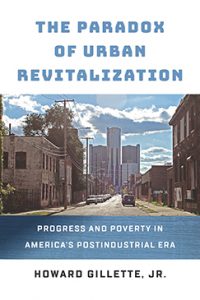
In the twenty-first century, cities in the United States that had suffered most the shift to a postindustrial era entered a period widely proclaimed as an urban renaissance. From Detroit to Newark to Oakland and elsewhere commentators saw cities rising again. Yet revitalization generated a second urban crisis marked by growing inequality and civil unrest reminiscent of the upheavals associated with the first urban crisis in the mid-twentieth century. The urban poor and residents of color have remained very much at a disadvantage in the face of racially biased capital investments, narrowing options for affordable housing, and mass incarceration. In profiling nine cities grappling with challenges of the twenty-first century, author Howard Gillette, Jr. evaluates the uneven efforts to secure racial and class equity as city fortunes have risen. Charting the tension between the practice of corporate subsidy and efforts to assure social justice, The Paradox of Urban Revitalization assesses the course of urban politics and policy over the past half century, before the COVID-19 pandemic upended everything, and details prospects for achieving greater equity in the years ahead.
Hear the New Books Network podcast about the book.
“Gillette superbly draws a set of nine urban portraits, cities addressing the tensions between economic development, equity, and community engagement…[C]ities can and should do more than what they are doing to balance the three goals of equity, economic development, and community engagement. They can benefit from implementation lessons described in this book. Howard Gillette has helped us understand the limits of what can be accomplished at the metropolitan level to resolve tensions between these three goals.”—Housing Studies
“[A] welcome addition to canonical urban planning history and theory…Gillette shows how local government policymaking can make a difference and that there are ways—albeit imperfect—to counter growth machine politics of corporate subsidies and creative-class hangouts. Gillette advances that a paradox of ‘progress’ is grinding poverty and dispossession. Contemporary city leaders must intentionally harness urban growth toward more equitable development. Experts and non-experts alike have much to learn from that frame.”—Journal of the American Planning Association.
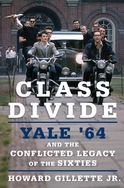
In Class Divide (Cornell University Press, 2015), Howard Gillette draws particularly on more than one hundred interviews with representative members of the Yale class of ’64 to examine how they were challenged by the issues that would define the 1960s: civil rights, the power of the state at home and abroad, sexual mores and personal liberty, religious faith, and social responsibility. Among those whose life courses Gillette follows from their formative years in college through the years after graduation are the politicians Joe Lieberman and John Ashcroft, the Harvard humanities professor Stephen Greenblatt, the environmental leader Gus Speth, and the civil rights activist Stephen Bingham.

click for Amazon link
Civitas by Design: Building Better Communities, from the Garden City to the New Urbanism. Philadelphia: University of Pennsylvania Press, 2010.
“Gillette expertly and efficiently marches the reader through the main planning and reform movements of the late nineteenth, twentieth and early twenty-first centuries, focusing on those thinkers, movements and places that reflect a concern for the utility of design in promoting good community life.” —Planning Perspectives
Gillette’s book “should be read by design professionals and should be required reading for all students of urban design, architecture, and planning.” —Canadian Planning and Policy
“Gillette’s latest volume is an efficient, astute, frequently contrarian survey of significant moments since the Progressive era in which professional planners and other shapers of American space have seen fit to scale up their interventions in the urban fabric, crafting notionally comprehensive habitats in the name of what Paul Boyer long ago called “positive environmentalism.” Gillette makes no claims to exhaustive coverage, but Civitas by Design reads as a summation of the main currents of twentieth-century planning thought—and a selective projection of its lessons onto future practice,” Urban Geography
Listen to Howard Gillette’s interview (30 MB mp3, 33:31 min.) about Civitas by Design, from University of Pennsylvania Press Podcasts. For further information about the book, see the featured interview Of July 10, 2012 on Rorotoko.
Camden After the Fall: Decline and Renewal in a Post-Industrial City (Politics and Culture in Modern America). Philadelphia: University of Pennsylvania Press, 2005. Winner of best book prizes from the Urban History Association and the New Jersey Historical Commission.
A masterly narrative of the twists and turns of Camden’s renewal politics from the perspective of local politicians, regional and state power brokers, and citizens groups.”—Journal of American History
“A fascinating and frequently eloquent exploration of the city’s history since World War II.”—Camden Courier Post
“The best study so far about the virtual collapse in the late twentieth century of South Jersey’s largest city.”—New York Times
“A thorough, well-researched, and important book. Through a careful analysis of people and politics, Gillette challenges the accepted narrative of postwar urban decline. The story of Camden is of special consequence to urban historians, historians of late twentieth-century U.S. political economy, and students of contemporary urban policy. Gillette is certainly the person to tell that story.”—Robert Self, Brown University
“With keen insight, Howard Gillette movingly details how de-industrialization, suburbanization, racial isolation, and political exploitation reduced Camden from industrial powerhouse to America’s third poorest city. Through the rich biography of one city, Camden’s fall could be the story of the half-century decline of many industrial cities and their struggles to revive, just more so. Camden After the Fall will become a classic in the field of urban history.”—David Rusk, author of Inside Game/Outside Game: Winning Strategies for Saving Urban America
Between Justice and Beauty: Race, Planning, and the Failure of Urban Policy in Washington, D.C. Philadelphia: University of Pennsylvania Press paperback edition, 2006.
“Gillette’s clear focus on government gives thematic coherence to his insightful and engaging history, highlighting matters of physical development such as slum clearance, public housing construction, urban renewal, commercial development, transportation, and the planning of the monumental core.” –Steven J. Diner, Journal of Urban History
Washington Seen: A Photographic History, 1875-1965. Co-authored with Fredric M. Miller. Baltimore: Johns Hopkins University Press, 1995.
This long overdue volume takes a nuanced look at familiar photographs and also serves to circulate widely for the first time many others, depicting all classes and strata of society. –Washington History
